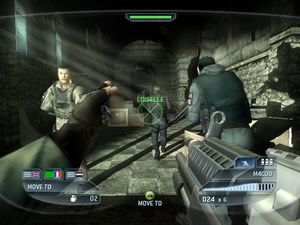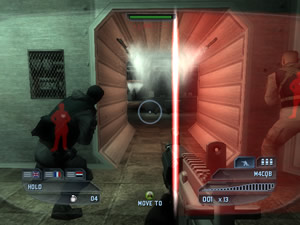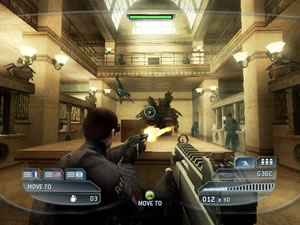The end of the rainbow?
Round about the time when Gay Pride asserted itself and Rainbow Brite horned in on the Cabbage Patch monopoly, the University of Hawaii changed its mascot to the Warriors, a far cry from its previous happy-go-lucky mascot, the Rainbows. Unwilling to accept the namby-pamby image usually associated with the colorful byproduct of a good rain, Tom Clancy’s anti-terrorist shooter, Rainbow Six, has stuck to its guns and held on to the name and franchise. If rainbows really do end at pots of gold, this one is protected by a leprechaun packing an uzi.
However, behind its tough-as-nails exterior, this fourth installment of the series is quite a different beast from its realistic forbears. Jettisoning most of the strategy, Rainbow Six: Lockdown feels much more like a standard first-person shooter with a sprinkle of squad-based tactics. While the result is more palatable for the everyday gamer, die-hard Rainbow Six fans may be disappointed.
Depending on your mood, you might say Rainbow Six: Lockdown is either streamlined and forgiving or dumbed-down and wimpy. Gone is the pre-mission strategy that allowed you to map out the insertion and route of your squad. In its stead is the familiar, linear rampage through buildings, rooms, and checkpoints that is the cardiovascular system of most first-person shooters. You may enter a room with three doors, but only one of them opens. You couldn’t get lost if you tried.
What does get lost, however, is the story, a spy-thriller hodgepodge mainly told through pre-mission briefings. That’s never been a good way to tell a story; you would think that Tom Clancy, of all people, would know how to inject some story into the action. But alas, you are told to “get the hostages” and hear nothing else until you’ve indeed gotten the hostages. From what I gather, you’ve been sent to stop terrorists who have stolen a biological weapon with the intent to force the WTO to forgive third-world debts. I’m all for killing terrorists, but why must these terrorists have such a good cause? I suppose Ding Chavez, your character, never took an oath to protect God, Country, and the International Monetary Fund. (I can hear Homeland Security pulling up to my porch…)
When it gets going, the gameplay is standard first-person-shooter fare. The controls are tight, the guns are varied and plentiful, and the enemies are lined up like sheep in a slaughterhouse. A subtle use of the Havok physics system powers the ragdoll physics, making this game seem more realistic in its violence than most. Also adding to the realism is the inability to heal throughout a mission, forcing the slower, more methodical pace that has always been a Rainbow Six staple. Subtracting from that realism is the lack of a jump button or a default melee attack. The running and gunning is no better or worse than any other decent first-person-shooter.
When your health gets low during the longer missions, you will find yourself relying more heavily upon your squad of teammates. You can direct them by pointing your cursor at a patch of floor and doling out simple commands. The teammate A.I. is pretty good, and they manage to find and take cover without much shepherding. The most useful squad function is the “delayed room clear’ command. When you assemble your squad at a door, they await your “go” command. By entering through a different door while simultaneously issuing the go command, you and your squad can storm a room from multiple entrances, confusing enemies and leaving them vulnerable in the rear.
A pain in that same rear, though, occurs when you realize you cannot issue individual commands to your individual teammates. You cannot, for example, bring one of your teammates with you while leaving the other two to guard an entrance. Other squad-based commands such as “suppress” and “grenade” are difficult to use effectively, and thus are not used at all. Most surprising was my “crack” team’s inability to duck under a garage door. Crack team indeed.
 Speaking of cracked, the graphics are messier than they should be. Edges are frequently jagged and the framerate is similarly rough. While the framerate doesn’t drop very often, it is set pretty low from the start, giving the whole game a jerky feel. Some neat visual effects like heat waves and rain splatters are pretty cool, as is the effect of the flashbang which polarizes and freezes the screen, gradually fading to show what you are looking at after running and shooting blind for several seconds. Good spice, but the meal is still too bland.
Speaking of cracked, the graphics are messier than they should be. Edges are frequently jagged and the framerate is similarly rough. While the framerate doesn’t drop very often, it is set pretty low from the start, giving the whole game a jerky feel. Some neat visual effects like heat waves and rain splatters are pretty cool, as is the effect of the flashbang which polarizes and freezes the screen, gradually fading to show what you are looking at after running and shooting blind for several seconds. Good spice, but the meal is still too bland.
Like Splinter Cell, the contrast between well-lit and darkened areas is extreme, which forces you to toggle between regular vision and night-vision incessantly. Unlike Splinter Cell, however, you do not need to stick to the pitch-black shadows at all as stealth is not a feature in this most recent Rainbow Six. Generally, the gameplay devolves into entering rooms and shooting everybody you see.
The enemy A.I. is a little slow, but your inability to heal and the great deal of time between checkpoints makes up for it. In turn, the single-player game can become frustrating because the run-and-shoot formula has been paired with a don’t-get-shot-ever overarching design.
Things change up a bit in the game’s online play. Both Xbox and PS2 versions feature Deathmatches and a couple Co-op modes, while the two differ in a few other modes like the Xbox-only Conquest (think King of Three Hills) and the PS2-only Rivalry (think objective-based maps).
Where the Xbox trumps the PS2 is in its exclusive P.E.C. (Persistent Elite Creation) mode, which enables you to develop and customize a specialized character type through earning points and medals in the online matches. When you first begin the online mode, you will be faced with a choice between four classes: Commando, Special-Ops, Engineer, and Medic. Each has different abilities and different arsenals, which are unlocked as you win matches. This kind of character persistence in a shooter is a great idea, and were it not for a couple rather glaring flaws, would be the game’s strongest selling point.
The biggest flaw at press time is that Medics cannot heal themselves or others. In what is obviously a serious oversight and embarrassing glitch for the Red Storm team, the Medic’s “health pack” can neither be recharged nor sold and bought again. After just a couple of matches, the Medic will have depleted his only health pack, becoming simply a gunner who can’t wear heavy armor, wield big guns, or do much more than stop a bullet. While online rumors promise a “patch” to fix the inept Medics, the game has been out for a week and many unfortunate gamers (myself included) have made the wrong choice already. And I just wanted to help people!
 The other big problem is that some of the online maps have a stubborn tendency to lag. Maybe this is due to the size of the maps, but it effectively limits the number of playable areas to just three or four environments.
The other big problem is that some of the online maps have a stubborn tendency to lag. Maybe this is due to the size of the maps, but it effectively limits the number of playable areas to just three or four environments.
There are also some easy exploits in the persistent leveling-up system ” players from the same clan can open up fake matches and politely take turns executing each other to boost XP – but that’s true of the first week in most any persistent online game, and the bulk of the scene is filled with fair gamers eagerly playing to unlock their next goodie or to earn money for that bad ass looking ski-mask. There are also a few disconsolate Medics wandering around, promising each other that a patch will be out “in the next few hours.” Sure. At least it’s testament to the addictive promise of new abilities that the Medics, despite their flaws, continue to fight the good fight.
The game doesn’t spend too much time on sound, and the wimp-rock muzak in the menus is about the only music around. Your squad will shout out little tidbits of information, like “hostile sighted” and “hostile down,” but it’s all just the standard chatter. The guns sound a little high-pitched, but my extensive combat experience has taught me that most rifles actually do sound a tad higher than they do in the movies.
If there’s one thing to be said in Rainbow Six: Lockdown’s defense, it is that the game is uncommonly deep. Featuring a Practice mode, several levels of difficulty, plenty of single-player meat and generous amounts of multiplayer, you cannot really ask for more ways to get at the game.
But you could ask for a better game in general. The new arcade-style squad control may make things quicker, but it short-circuits the one thing that made Rainbow Six different: intelligent squad strategy. And while the P.E.C. mode is a great step forward for those tired of the Halo 2 formula, its flawed and laggy play hinders its achievement. At times luminous and at other times just wet, this rainbow is missing a few colors.
-
Simple squad control
-
Cool P.E.C. mode
-
Plenty of other modes
-
Realistic damage, no health packs
-
No health packs for Medics?
-
No strategy
-
Lackluster presentation
-
Generic, uninteresting story











